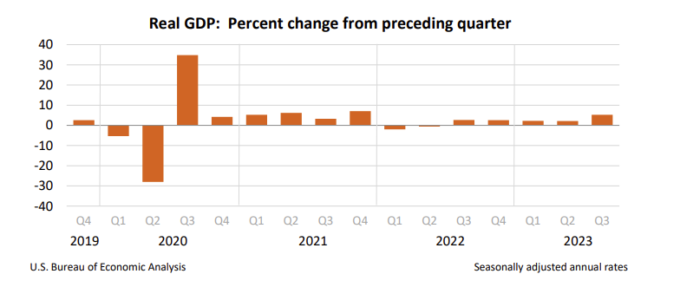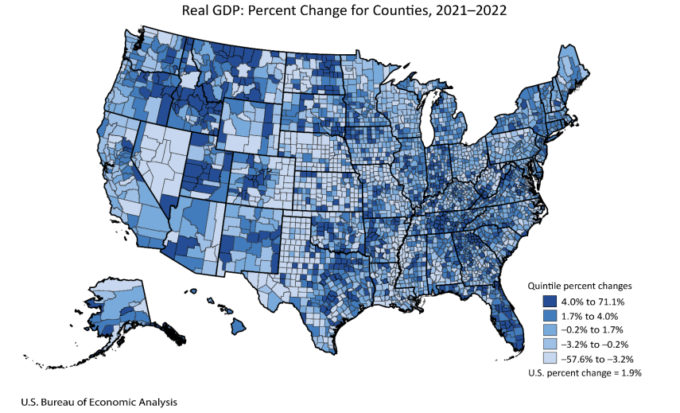Real gross domestic product (GDP) increased at an annual rate of 5.2% in the third quarter of 2023, a 0.3 percentage point increase from the preliminary estimate, according to the secondary estimate released by the Bureau of Economic Analysis. The increase in real GDP reflects upward revisions to nonresidential fixed investment and state and local government spending that were offset by a downward revision to consumer spending. Imports, a subtraction to GDP, were also revised down. Compared to the previous quarter, the acceleration of real GDP reflects increases in consumer spending and private inventory investment, an upturn in both exports and imports, and a deceleration in nonresidential fixed investment. Current-dollar personal income, disposable personal income, and personal saving were all revised upwards from the previous estimate. The first estimate for real gross domestic income, an alternative measure to GDP, was released at 1.5%, the average of Real GDP and Real GDP was 3.3%. –Delaney O’Kray-Murphy
[Note the third estimate for U.S. GDP will be released shortly after this article is published.]
HEALTHCARE NEWS: Who’s Who in Arizona Healthcare for 2024

Real GDP by state increased 1.5% in Arizona in the second quarter 2023, below the U.S. change of 2.1% for the same period. The percent change for states ranged from -1.9% in Vermont to 8.7% in Wyoming during the second quarter. Utilities increased in all 50 states and the District of Columbia and was the leading contributor to growth in 22 states, including Arizona. –Valorie Rice
After increasing substantially in 2021, real GDP decreased in half of Arizona’s counties in 2022 based on the recent U.S. Bureau of Economic Analysis’ Gross Domestic Product by County and Metropolitan Area 2022 release. Arizona counties that continued to see a boost in real GDP for 2022 were Yuma (6.2%), Maricopa (4.1%), Coconino (2.8%), Pima (1.9%), Pinal (1.3%), Santa Cruz (0.4%), and Yavapai (0.1%). Cochise County decreased in both 2021 and 2022 with a -0.5% change in 2022, while the remaining counties went from positive changes in 2021 to decreases in 2022. These were Mohave (-0.2%), Navajo (-0.5%), Gila (-2.9%), Apache (-4.8%), Graham (-8.2%), La Paz (-8.6%). Greenlee County had the largest gap, going from an increase of 23.9% in 2021 to -16.2% in 2022. Nationally, the percent change in real GDP for 2022 ranged from a drop of 57.6% in Kiowa County, CO to an increase of 71.1% in Chouteau County, MT. –Valorie Rice

U.S. house prices rose 3.9% over the year in September, up from the 2.5% figure presented in August, based on the S&P CoreLogic Case-Shiller November 28th release. On the other hand, both Phoenix and Las Vegas showed over-the-year decreases in home prices, with Phoenix representing a -1.2% yearly change and Las Vegas -1.9%. The only other of the 20-city composite that showed an over-the-year decrease was Portland at -0.7%. Detroit showed the largest increase in home values, at 6.7%, followed by San Diego at 6.5% and New York at 6.3%.–Delaney O’Kray-Murphy
House prices increased in every state but Hawaii between the third quarter of 2022 and third quarter of 2023 according to the latest Federal Housing Finance Agency (FHFA) release. House price appreciation in Arizona was 1.9% over the year in the third quarter of 2023, lower than the national price change of 5.5%. New England states of Vermont and Maine had the largest appreciation during the period with 11.8% and 11.1% respectively. These data represent the purchase-only index while metropolitan area data are available with the all-transactions index, which includes purchase and refinance mortgages. Ranked by the one-year change in house prices, Arizona metropolitan areas in the third quarter of 2023 were: 5.7% in Yuma, 4.5% in Flagstaff, 3.1% in Tucson, 3.0% in Sierra Vista-Douglas, -0.5% in Prescott Valley-Prescott, -0.8% in Lake Havasu City-Kingman, and -1.7% in Phoenix. When included in the all-transaction index, the one-year price changes for Arizona and the U.S. move down to -0.4% and 4.8% respectively. –Valorie Rice




